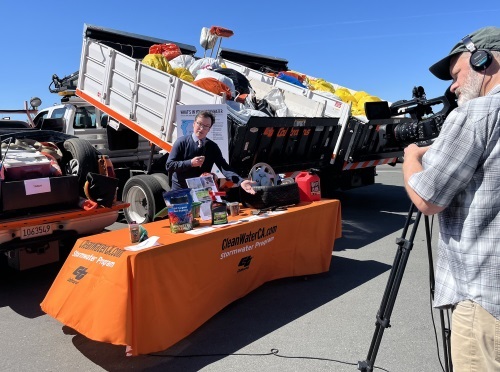As part of its “Let’s Change This to That” public education campaign, the California Department of Transportation is highlighting the top six sources of stormwater pollution across the state as well as ways to prevent them from contaminating California’s waterways.
[Above photo by Caltrans]
The agency manages stormwater runoff and mitigates potential pollution within its 350,000 acres of right of way, which includes more than 15,000 centerline miles of highways. This effort involves picking up roadside litter and clearing out storm drains to preserve roadway safety and drivability during all types of weather conditions.
Unlike water that goes down the sink or toilet in a home, Caltrans said stormwater is untreated and flows directly into lakes, rivers, and other waterways.
The agency noted that as stormwater travels into storm drains, it captures pollutants from highways, streets, sidewalks, and yards that flow into waterways. The top six pollutants have an outsized impact on the water quality of lakes, rivers, streams, and the ocean, and many are preventable through small actions Californians can take:
- Trash and litter: Properly secure items in truck beds and put trash and recycling in the correct bin.
- Sediments: Prevent soil erosion by using mulch in the garden, planting trees and shrubs, and sweeping driveways instead of hosing them off.
- Nutrients: Avoid over-fertilizing lawns and plants and limit vegetation waste by keeping fallen leaves out of storm drains.
- Bacteria: Limit pet and Recreational Vehicle or RV waste by picking up after your pet and using appropriate RV dumping stations.
- Metals: Regularly check tire pressure, change oil and fluids, and use commercial car washes to prevent metals generated from vehicle, tire, and brake wear from ending up on highways.
- Pesticides: Use organic pesticides and properly dispose of unused portions.
“Preventing stormwater pollution requires the help and support of every Californian, and it starts with keeping highways and roadways clean,” noted Steven Keck, acting director at Caltrans, in a statement.
“Californians must work together to take necessary steps to prevent pollution at the source and keep our waterways clean,” he said.
With the intensify drought conditions predicted to increase statewide this year, Caltrans noted it is amplifying water quality as a top priority.
During a drought, the state’s lakes, rivers, and streams have lower water levels, which leads to a higher concentration of pollutants. By preventing a buildup of metals, trash, and other pollutants on highways and roadways in dry conditions, Californians can help keep pollutants from traveling into local waterways during rainstorms.

